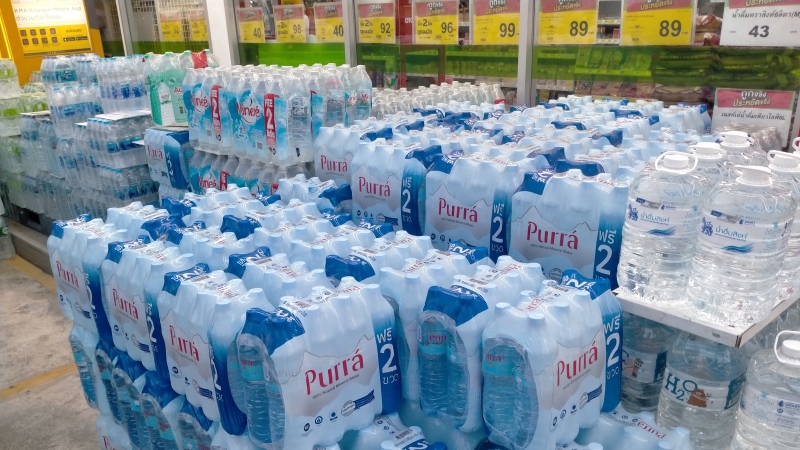We all know that the world has a plastic problem and that it is bad in Phuket, where bottles, bags and packaging clog our klongs, clutter our beaches and pollute our oceans. Nevertheless, on any given day, you will see locals and tourists alike guzzling litres of bottled water on every street corner and in every restaurant around the island.
In my previous article ‘7 Reasons to Stop Drinking Bottled Water’, I wrote about how bottled water is depleting water supplies, creating pollution, destroying the environment, contributing to climate change, costing us money and hurting our health.
Why plastic pollution is worse than you think
A January 2024 study by scientists at Columbia University vs. Rutgers University shows that bottled water may be 10-100 times worse for our health than originally suspected. This is because microscopic plastic pollutants that are smaller than 1 micrometre (1μm ‒ 1 millionth of a metre, or 1/25,000th of an inch), also known as nanoplastics, can pass into the bloodstream, the intestines and the lungs. From there, they can enter the heart and other organs and can even get through the blood-brain barrier.
Scientists have been warning us about the threat from microplastics for years and estimate that each of us consumes about 1 credit card (5 grammes) of plastic each week, breathing it into our lungs from shedding fibres of clothes and fabric and eating and drinking it through contaminated food and water.
Previous studies measured only particles that ranged from 5mm to 1μm and found that a one-litre water bottle could contain tens of thousands of microplastics.
This recent study, published Jan 8, 2024 in the journal Proceedings of the National Academy of Sciences, measured particles smaller than 1μm using new laser technology and found that there were between 10-100 times more fragments than originally thought. In fact, about 90% of the particles inside of a water bottle are nanoplastics smaller than 1μm.
Scientists suspect that micro and nanoplastics are created from small abrasions that occur when the bottle cap is unscrewed or when a bottle is squeezed. Exposure to heat can also cause plastic to break down.
Do nanoplastics harm our health?
Although there are not many studies on how microplastics or nanoplastic affect human health, there is evidence that the chemicals used in plastic production are toxic to humans and other mammals, especially to our reproductive health.
For example, a study published in the medical journal Annals of Global Health found that workers involved in plastic production, plastic recycling workers and those living near plastic manufacturing plants have an increased risk of cancers, including leukaemia, lung, lymphoma, brain, breast and mesothelioma. They also have higher levels of cardiovascular disease, asthma and COPD (chronic obstructive pulmonary disease). Children or infants in the womb are at particularly high risk.
Another recent study published in the journal Toxological Sciences studied tissue samples of 62 placentas and found microplastics in every single one of them. Most of the particles were from polyethylene, or PET, the most common type of plastic used to make bottles and bags. Researchers believe that these particles can cause inflammation in our cells, resulting in diseases including colon cancer, inflammatory bowel disease and even a decline in sperm count.
The effects on placentas are still unknown, but according to Prof Campen from the University of New Mexico, who led the research, the concentration of microplastics in placentas was especially troubling because the tissue grows for only eight months, but “other organs of your body are accumulating over much longer periods of time.”
How to reduce your exposure to plastic
The problem is that plastic has become ubiquitous and scientists have found pieces of it in remote locations far away from humans, such as the Marianna Trench and the Arctic. So, although you will not be able to eliminate your exposure to plastic particles, here are some ways you can reduce it:
- Buy a water filter for your tap. These cost less than B3,000 on Lazada. You can also buy more complex, expensive filtration systems at HomePro.
- Get water from a machine. There are reverse-osmosis water machines that cost B1 per litre of filtered water located all over the island. They are usually near a 7-Eleven or Lotus’s. To reduce your exposure to plastic, buy a metal, glass or ceramic container to store your water in.
- Do not microwave food in plastic containers, even if it says they are microwave safe, because it can leach dangerous chemicals into your food.
- Stop using plastic wrap to cover your food. These contain phthalates, a chemical used to make it more flexible and are detrimental to human health.
- If you want to be extra careful, a new study published on February 28, 2024 says that you can remove up to 90% of microplastics by boiling your water for 5 minutes, which traps them in the calcium carbonate in the water. The researchers said that afterwards you should use a simple coffee filter to remove the solidified calcium particles which could be harmful to your health.
The plastic problem is not going away anytime soon. Even though you will not be able to stop using it entirely, until food manufacturers change their packaging, you can at least minimise your exposure to microplastics and nanoplastics by not continuing to drink bottled water.
Palmer Owyoung is the author of ‘Solving the Climate Crisis: A Community Guide to Solving the Biggest Problem On the Planet.’ You can download the first three chapters from his blog PalmerOwyoung.me








